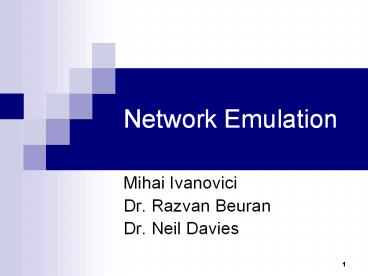Network%20Emulation - PowerPoint PPT Presentation
Title:
Network%20Emulation
Description:
Current emulators. Do exist. Mainly software based. Packet by packet systems ... Why another emulator? More realistic scenarios. Intra-stream and inter-stream ... – PowerPoint PPT presentation
Number of Views:65
Avg rating:3.0/5.0
Title: Network%20Emulation
1
Network Emulation
- Mihai Ivanovici
- Dr. Razvan Beuran
- Dr. Neil Davies
2
Quality of Service
- What is quality for a network / application
- Quality is finite
- How is it
- Shared (between different traffic flows)
- Managed (at the contention points)
- Delivered (to the application / user)
- Perceived (by the user)
- View points
- Local view (at a point in network)
- Global view (end to end)
3
Application outcomes
The judgment metric application outcomes
4
Needed elements
- Model of interaction between application and
delivered quality from network - Environment for evaluation of existing
applications - Capture process to apply to existing / proposed
developments - ? Combine to create a well-defined methodology
for assessing application performance
5
Assessing application performance
- In parallel
- Measure the network QoS parameters
- Assess the UPQ for the application under test
6
Current emulators
- Do exist
- Mainly software based
- Packet by packet systems
- Independent loss and delay applied to packets
unrealistic behaviour - False packet reordering
- No intra-stream contention modelled
7
Why another emulator?
- More realistic scenarios
- Intra-stream and inter-stream contention
- Correlated loss and delay, natural induced jitter
- Phase / mode changes in network
- Topology or environment changes (e.g. wireless)
- More flexibility and control on the degradation
models
8
Why another emulator? (II)
- Safety critical / mission critical viewpoint
- How the systems operate under various network
conditions - Its not just about normal situations
- How and when applications fail
- Speeds up to 1 Gbps
9
The hardware platform
10
How we do it
The packet processor
The packet path
The control path
11
The architecture
12
Network in a box
- Predictable reproducible network behaviour and
application errors - Regression testing
13
The ?Q concept
Total degradation in the network aggregation of
the degradation induced by each sub-network and
network element on the way
14
Intra-stream contention
- Competition for resources
- Sharing the connection ? THROUGHPUT
- Entering the queues ? LOSS
- Leaving the queues ? DELAY
- How applications react to quality degradation
- Model the effects of application behaviour on
quality degradation - e.g. burst loss behaviour on TCP/IP
15
Inter-stream contention
- The total amount of degradation is shared between
different streams - By use of scheduling mechanisms (e.g. SP, WRR)
- Differentially treat the traffic to achieve the
best application outcomes
16
First versions
- Fixed delay one queue
- Constant service time
- Bandwidth limitation
- Fixed delay one queue
- The effect of other traffic flows sharing the
same network/path emulated as server vacations
17
The next step
- More sophisticated network models for the server
with vacations - Aggregation of simple models of queues and
wires
18
Conclusions
- We propose a methodology for assessing
application performance - Network emulation
- Allows a hybrid test technique
- Combines the advantages of simulation and real
application/networks testing































